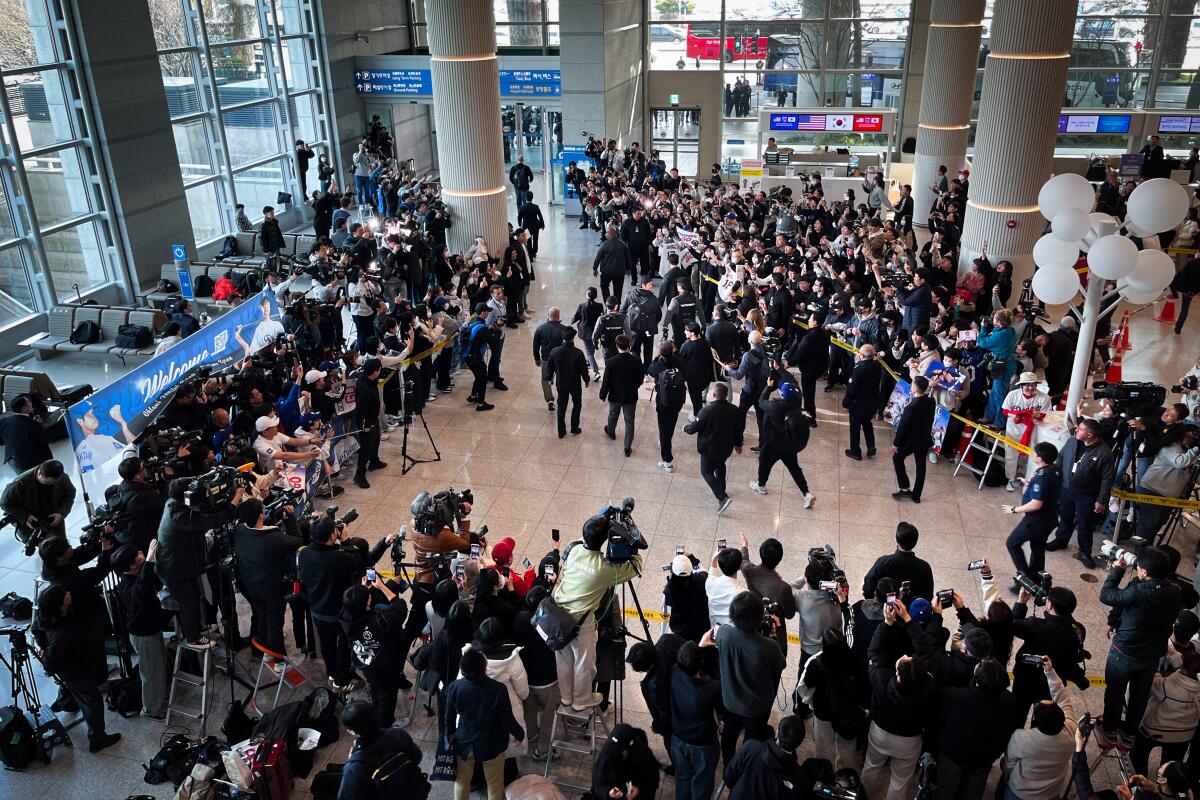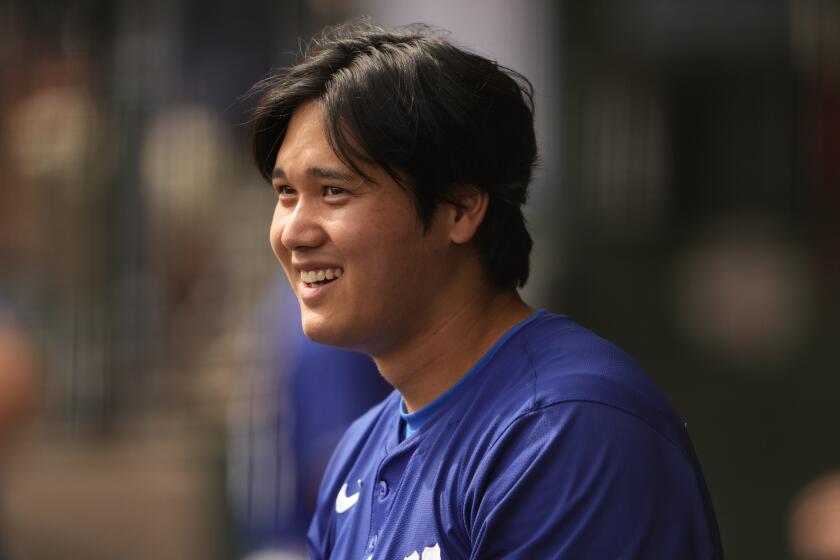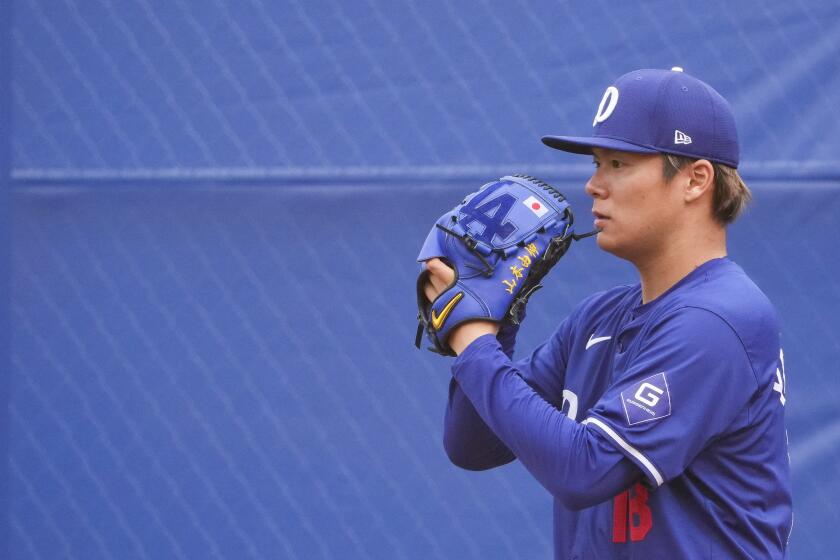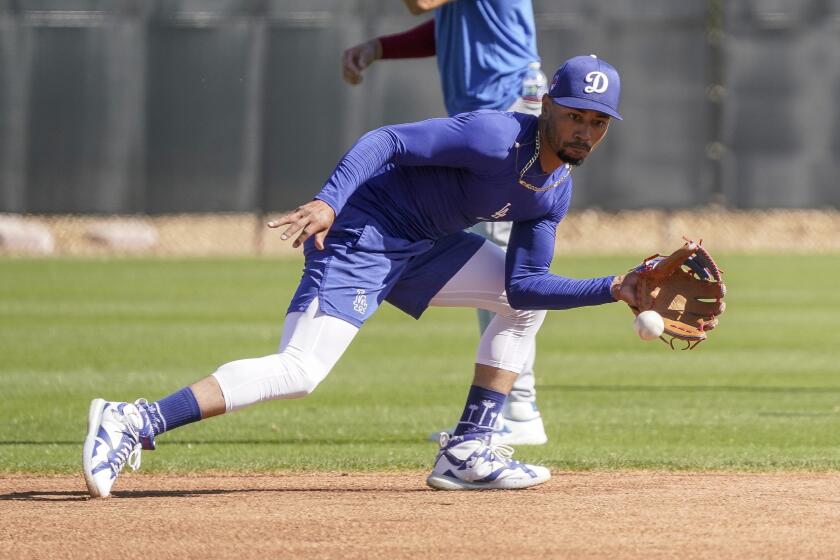Padres aren’t the only challenge for Dodgers in playing series in South Korea

- Share via
SEOUL — As Brandon McDaniel, the Dodgers’ vice president of player performance, walked through the team’s spring training clubhouse last week, he laughed when a reporter stopped him to ask about the season-opening trip to South Korea.
How much time had he, like many others in the organization, spent during camp preparing players for the international series?
“It’s kind of been my whole life lately,” he said with a chuckle. “We’re just doing everything we can to put a plan in place.”
The trek began Thursday morning in Phoenix, when players, officials, staffers and family members boarded a chartered Boeing 747 and took off for Seoul. After cruising at 34,000 feet for the next 12 hours 41 minutes, the team arrived at Incheon Airport, just outside of Seoul, on Friday afternoon at 1:22 local time.
The Dodgers’ signing of Shohei Ohtani amid his emergence as a global star has wildly accelerated sales — and prices — of tickets to see the Dodgers.
The season-opening two-game series against the San Diego Padres at the Gocheok Sky Dome on Wednesday and Thursday, still was days away. However, in hopes of preparing players for not just the Korean series, but also the 160 games that will remain when they fly back to Los Angeles next week, the team’s plan already was well underway by the time the plane touched down almost 6,000 miles away from home.
The goal, McDaniel said, is “to get guys acclimated. Not only there, but on the way back too. At the end of the day, we’re going over there to play two games. We want to win those two games and maximize those. But we also want to come back and maximize for the rest of the season.”
That process began in earnest this week in the Dodgers’ final days in Arizona. On Monday the club invited a sleep specialist in to speak to players in the clubhouse at Camelback Ranch. The two main pieces of advice they received: start hydrating immediately to help their bodies handle the trans-Pacific travel, and, to adjust their sleep schedule, stay up late the night before the flight to Seoul.
Unlike the Padres, who left for Korea following their final Cactus League game Wednesday night (they arrived in Seoul in the early hours of Friday morning), the Dodgers opted for a Thursday morning departure, hopeful it would make for a more seamless transition to the 16-hour time difference.
Thus, Dodgers players were instructed to sleep little Wednesday night, when it was already Thursday afternoon in Seoul; get plenty of shuteye during the first half of Thursday’s flight, when it would be Thursday night in Seoul; and, hopefully, trick their internal clocks to be on South Korean time as soon as they landed.
“It’s definitely not gonna work for everybody,” McDaniel said. “There are gonna be some people that wake up at 3 in the morning, probably wide awake. Everybody’s internal clock is different. But we’re doing everything we can.”
That included an optional workout Friday evening at the Sky Dome, just five hours after arrival. Its purpose?
The roots of Yoshinobu Yamamoto’s success? The choice to defy convention and be willing to adapt even at an early stage of his career with the Orix Buffaloes.
“Sweat, eat, stay awake until it’s time for bed,” McDaniel said. “It’s not something I would necessarily classify as difficult. Playing is difficult. New surroundings sometimes are difficult. But we just want for our guys to maximize the flight, maximize the arrival and try to get on Seoul time as quickly as possible.”
McDaniel had previous experience planning such an arduous trip. Ten years ago he was in his second season as the Dodgers’ strength coach when the team opened its season in Sydney, Australia, with two games against the Arizona Diamondbacks.
That series, held at the Sydney Cricket Ground, helped grow the game Down Under — but came with some injuries that, in hindsight, were seen as side effects of the strenuous spring schedule.
Dodgers ace Clayton Kershaw strained a back muscle during his opening day start, the most severe injury of his career to that point. Kershaw missed more than a month. Reliever Brian Wilson also went on the injured list because of an elbow issue following the trip.
The Diamondbacks, meanwhile, lost two key pitchers on either side of the trip. Ace left-hander Patrick Corbin suffered a torn ulnar collateral ligament before the team left. Setup man David Hernandez sustained the same injury after getting back. Both underwent Tommy John surgery and missed the season.

Some felt that the burdens of the shortened spring camp and lengthy international travel were partially to blame. Wilson said he felt rushed getting ready for the season.
A decade later, Kershaw still acknowledges that while he cherished the experience of going to Australia, “the baseball part of it was a little challenging.”
“I just felt something throwing in the game,” Kershaw recalled last week of the first of several back ailments that have plagued him. “Who can say what it was from. But [the schedule] probably didn’t help.”
Kershaw is confident this time will be different.
Before the rest of the team left for Korea — Kershaw isn’t on the trip as he recovers from offseason shoulder surgery — the veteran left-hander downplayed concerns about any repeat rash of pitcher injuries.
Whereas Kershaw ramped up to throw more than 100 pitches in Australia — he tossed 102 in his 6⅔-inning start — the scheduled starters for this series, Tyler Glasnow and Yoshinobu Yamamoto, were brought along at a slower, safer pace.
Neither is expected to throw more than five innings or 85 pitches. And both have expressed confidence about handling the physical demands of the trip.
“We’ve learned 10 years later that you gotta continue to do the normal build-up no matter what,” Kershaw said. “Just taking a little more cautious approach compared to what we did 10 years ago.”
The Dodgers also have more remedies to rely on than they did in 2014. McDaniel said players were given nutrition and sleep supplements to help battle jet lag. They had compression socks to avoid discomfort or swelling in their legs during the flight.
Mookie Betts is no stranger to the shortstop position. Nevertheless, it’s a daunting task taking on the role for an entire season.
Most of all, they made use of Firefly devices — small leg bands that use electrical pulses to increase blood flow and, as a result, improve physical recovery.
“We added a lot of those ancillary things to make the most of this,” McDaniel said. “I don’t want to make this [trip] a big deal. I don’t want guys to be like, ‘Oh my god, I can’t perform.’”
Time will tell how well the extensive planning translates on the field.
The Dodgers hold their first official workout of the trip Saturday. They will scrimmage Sunday and Monday against a couple of Korean teams. Then they will try to start the season on the right note, hoping to return to the U.S. with two early wins and few worries about reacclimating for the rest of their season.
“We have a plan in place, we’re gonna take the right steps, and at the end of the day, we gotta go play two games,” McDaniel said. “It’s gonna be great.”
More to Read
Are you a true-blue fan?
Get our Dodgers Dugout newsletter for insights, news and much more.
You may occasionally receive promotional content from the Los Angeles Times.










